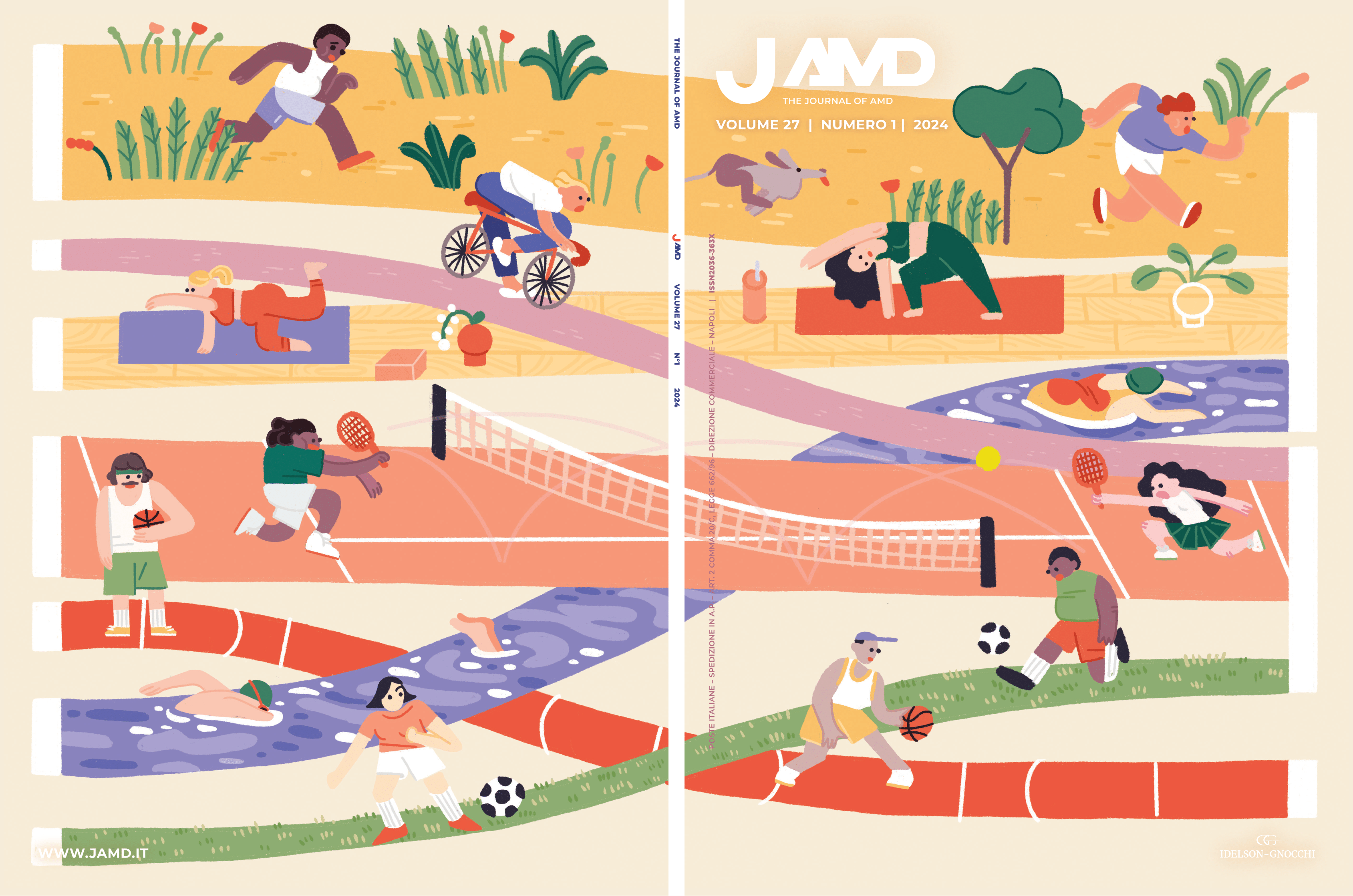Editorial
We cannot do without the SSN
JAMD 2024;27(1):4-5
Original articles
Kidney disease with rapid eGFR decline in type 2 diabetes: an analysis of the AMD Annals
JAMD 2024;27(1):6-14
BACKGROUND Rapid estimated glomerular filtration rate (eGFR) decline is an independent predictor of End Stage Kidney Disease (ESKD) and death in subjects with type 2 diabetes mellitus (T2D), but epidemiological data on this phenotype are still lacking. This article assessed the prevalence and clinical characteristics of T2D subjects with rapid eGFR decline. AIM In a sample of subjects with newly diagnosed T2D from the large dataset of the AMD Annals initiative, we investigated the prevalence and clinical factors associated with a rapid eGFR decline. METHODS Retrospective longitudinal analysis from Associazione Medici Diabetologi (AMD) Annals database. Rapid eGFR decline was defined as an eGFR decline greater than 5 mL/min/1.73 m2 per year during 3 years from diagnosis of T2D.
RESULTS Among 105,163 (57.7% M) subjects with newly diagnosed T2D, 12.9% subjects showed a rapid eGFR loss. A projection of eGFR loss curves overtime showed that these subjects would reach ESKD after 8-9 years from the T2D diagnosis. T2D subjects showing a rapid eGFR loss were older, with a higher prevalence of female gender, worse atherogenic dyslipidemia (lower HDL and higher triglyceride levels), higher systolic blood pressure, micro/macroalbuminuria and a higher prevalence of cardiovascular disease and retinopathy. CONCLUSION In a large sample of newly diagnosed T2D subjects, we identified 12.9% of subjects with a rapid eGFR decline. It is necessary to early identify and treat these subjects who may need dialytic treatment within 10 years from the diagnosis of T2D.
KEY WORDS newly diagnosis of type 2 diabetes; diabetes Kidney disease; eGFR rapid decliners; AMD annals initiative.
Glycemic variability, HbA1c variability, and Time in range: emerging role in the development of diabetes complications
JAMD 2024;27(1):15-21
Glycated hemoglobin (HbA1c) is the main metric for assessing glycemic control in patients with diabetes. HbA1c senses directly the average blood glucose level but does not intercept fluctuations in blood glucose over time. Recent data suggest that additional metrics of glycemic control hold predictive value for the development of diabetes complications. Glucose and HbA1c variability are both emerging as independent risk factors for the development of complications. The assessment of short-term glycemic variability, measured as a coefficient of variation, is possible with continuous glucose monitoring (CGM), an instrument that also provides data on a recently introduced metric, i.e. the Time in Range (TIR). TIR, i.e. the percentage of time spent by the patient in the glycemic range between 70 and 180 mg/dl, is associated with with glycemic fluctuations and represents an independent risk factor for the development of complications. More recently, the use of an additional metric has been proposed, which is the Time In Tight Range (TITR), i.e. the percentage of time spent by the patient in the glycemic window between 70 and 140 mg/dl, for which data are beginning to emerge from cohorts of patients with type 1 diabetes. In this review, we will discuss the main findings relative to the impact of TIR, glucose variability, and HbA1c variability on the development of complications, highlighting also the possible influence of selected glucose-lowering drugs on these metrics.
KEY WORDS diabetes; TIR; HbA1c; glycemic variability; HbA1c variability; complications; cardiovascular diseases.
Surveys
Survey on diabetologists’ interest in prescribing Physical Exercise in clinical practice
JAMD 2024;27(1):22-29
INTRODUCTION Scientific and clinical evidence emphasizes the importance of the practice of physical exercise (PE) in the prevention and treatment of the most common chronic non-communicable diseases, including type 2 diabetes mellitus. The same evidence emphasizes the importance of identifying and eliminating barriers to patients’ behaviour change. The lack of prescription of PE by the multidisciplinary diabetes team is one of the most important, among such barriers. Therefore, the aim of the study was to identify the presence of barriers related to the knowledge of the importance of PE and its prescription, as well as to the knowledge of the area of Sports Sciences, by medical specialists.
MATERIALS AND METHODS Between June and July 2023, the AMDSID inter-association study group “Diabetes and physical activity” promoted a web-based survey, sent to AMD and SID members via institutional newsletters.
RESULTS Of the 415 responding doctors, the majority (i.e. 66%) were working in a diabetology service, 76.4% of them were physically active, 99.5% considered PE important in the treatment path of the diabetic patient and 96.9% of respondents believed that technical support for the self-management of PE could be helpful in the therapeutic education phase. However, 59.8% of respondents declared that they did not have sufficient knowledge concerning PE, 94.9% would be willing to participate in training implementation seminars for PE prescription, and 78.3% declared that they were not aware of the existence and the role of the specialized kinesiologist.
CONCLUSIONS The results underline the importance and the necessity of encouraging training of healthcare providers in the field of PE and promoting interprofessional collaboration with kinesiologists.
KEY WORDS exercise; diabetes mellitus; prescription.
“Nota 100 AIFA”: fact-finding survey for General Practitioners and Specialists
JAMD 2024;27(1):30-38
The 2021-2023 AMD Regional Presidents’ Council promoted two parallel surveys on Nota 100 Aifa, one addressed to general practitioners, and the other to specialists, aimed at investigating the use, satisfaction, and any advantages or critical issues linked to the aforementioned provision. For this purpose, we proposed an online questionnaire, consisting of 23 specific questions which were answered by 555 GPs and 332 specialists. The analysis of the results highlights how a theoretically epochal measure for GPs has not yet fully achieved the purpose for which it was conceived and is therefore still largely underused. Two years after its promulgation, critical issues remain, mainly of bureaucratic and training nature, which prevent its complete and uniform application such as to be able to translate into a broader and more productive collaboration between the actors involved and an indisputable benefit for the patient with diabetes.
KEYWORDS type 2 diabetes mellitus; nota 100 AIFA; general practitioner; specialist.
Simposio
Heart failure in type 2 diabetes: epidemiological aspects, classification, and risk factors
JAMD 2024;27(1):40-46
Heart failure (HF) and type 2 diabetes mellitus (T2DM) are interconnected conditions that present significant public health challenges due to their rising global incidence. This paper explores the epidemiological aspects, classifications, and risk factors of HF in patients with T2DM, providing insights that contribute to the understanding and management of this complex interplay. Cardiovascular diseases are the leading cause of death in T2DM patients, with hyperglycemia and insulin resistance serving as critical, independent risk factors for atherosclerotic disease. This review highlights the predominance of cardiovascular risk factors in T2DM patients years before clinical manifestations, with HF being a leading cause of hospitalization in these patients in Italy. Diabetic cardiomyopathy, distinct from ischemic cardiomyopathy, is increasingly recognized and attributed to various mechanisms, including inappropriate activation of the renin-angiotensin system, sub-cellular alterations, oxidative stress, and inflammation, which promote interstitial fibrosis and diastolic dysfunction. Furthermore, the intersection between T2DM and HF is of particular clinical and epidemiological interest, as T2DM not only increases the risk of developing HF but also complicates patient management and prognosis. The classification of HF in the context of diabetes is crucial for guiding therapeutic choices and predicting clinical outcomes. This paper underscores the importance of a multifactorial approach to the prevention and management of HF in T2DM patients, emphasizing the necessity of early diagnosis and regular monitoring to prevent progression to more severe cardiac dysfunction.
KEY WORDS heart failure, type 2 diabetes, diabetic cardiomyopathy, risk factors, epidemiology.
Clinical and instrumental diagnosis of heart failure
JAMD 2024;27(1):47-53
Type 2 diabetes mellitus (T2DM) is a known predisposing factor for heart failure (HF). The growing burden of these two conditions and their impact on health of the individual and on society in general needs urgent attention from the health care professionals. Availability of multiple treatment choices for managing T2DM and HF may make therapeutic decisions more complex for clinicians. Recent cardiovascular outcome trials of antidiabetic drugs have added very robust evidence to effectively manage subjects with this dual condition. This paper provides the prevalence trends and the impact of this dual burden on patients. In addition, it concisely narrates the types of HF, and suggestions for physicians to manage such patients.
KEY WORDS type 2 diabetes mellitus; heart failure; diagnosis; drugs.
Use of natriuretic peptides in screening, diagnosis, and monitoring of heart failure
JAMD 2024;27(1):54-67
Natriuretic peptides (NPs) are polypeptide hormones produced by myocardiocytes that regulate volemia and natremia to ensure cardiovascular system homeostasis. BNP and NT-proBNP are the NPs with the most robust evidence and their use is currently indicated by international guidelines. Low NPs values can exclude a diagnosis of heart failure (HF) with a high negative predictive value, both in emergency (BNP <100 pg/ml, NT-proBNP <300 pg/ml) and in outpatient settings (BNP <35 pg/ml and NT-proBNP <125 pg/ml). In addition, the ESC 2023 consensus document suggests threshold values for inclusion diagnosis. High NPs values are also associated with increased risk of major cardiovascular events, cardiovascular mortality, and all-cause mortality in both inpatient and outpatient setting. In patients at risk for HF (with diabetes mellitus, hypertension, or vascular disease), assessment of NPs is useful in stratifying their cardiovascular risk, optimizing therapy, and reducing the risk of developing overt HF. Risk stratification by PNs can guide the diabetologist to a more informed and appropriate therapeutic choice. NPs must be interpreted in light of certain variables that may affect their reliability, such as renal function, body weight, sex and age. In conclusion, NPs are known to be useful in the diagnosis and prognosis of SC, but they also offer advantages in preventive setting.
KEY WORDS natriuretic peptides; NT-proBNP; BNP; heart failure; diabetes mellitus.
An update on the treatment of heart failure in people with diabetes: news from the ESC guidelines
JAMD 2024;27(1):68-74
Heart failure (HF) therapy has become increasingly complex in recent years and important evidence from clinical studies has extended the therapeutic options available across the entire left ventricular ejection fraction (LVEF) spectrum. The 2023 update of the 2021 guidelines of the European Society of Cardiology (ESC) on acute and chronic HF, confirms the use of sodium-glucose co-transporter-2 (SGLT2) inhibitors in HF with reduced ejection fraction (HFrEF) but establishes the role of these drugs also in therapy of HF with preserved (HFpEF) and mildly reduced ejection fraction (HFmrEF), and also in acute HF. The therapeutic value of finerenone, a new non-steroidal mineralocorticoid receptor antagonist (MRA) for reducing the risk of hospitalization for HF in patients with chronic renal failure and type 2 diabetes (DMT2), is also recognized.
KEY WORDS heart failure; SGLT2 inhibitors; finerenone; type 2 diabetes mellitus.
Punto di vista
Bioethical assumptions of non-aderence
JAMD 2024;27(1):75-77





